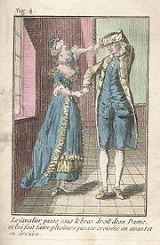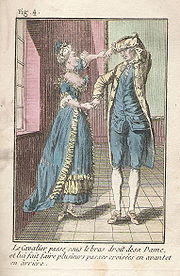
Allemande
Encyclopedia

French language
French is a Romance language spoken as a first language in France, the Romandy region in Switzerland, Wallonia and Brussels in Belgium, Monaco, the regions of Quebec and Acadia in Canada, and by various communities elsewhere. Second-language speakers of French are distributed throughout many parts...
word for "German") is one of the most popular instrumental
Instrumental
An instrumental is a musical composition or recording without lyrics or singing, although it might include some non-articulate vocal input; the music is primarily or exclusively produced by musical instruments....
dance
Dance
Dance is an art form that generally refers to movement of the body, usually rhythmic and to music, used as a form of expression, social interaction or presented in a spiritual or performance setting....
forms in Baroque music
Baroque music
Baroque music describes a style of Western Classical music approximately extending from 1600 to 1760. This era follows the Renaissance and was followed in turn by the Classical era...
, and a standard element of a suite
Suite
In music, a suite is an ordered set of instrumental or orchestral pieces normally performed in a concert setting rather than as accompaniment; they may be extracts from an opera, ballet , or incidental music to a play or film , or they may be entirely original movements .In the...
. Originally, the allemande formed the first movement of the suite, before the courante
Courante
The courante, corrente, coranto and corant are some of the names given to a family of triple metre dances from the late Renaissance and the Baroque era....
, but, later, it was often preceded by an introductory movement, such as a prelude
Prelude (music)
A prelude is a short piece of music, the form of which may vary from piece to piece. The prelude can be thought of as a preface. It may stand on its own or introduce another work...
.
The allemande originated in the 16th century (Renaissance) as a duple metre
Metre (music)
Meter or metre is a term that music has inherited from the rhythmic element of poetry where it means the number of lines in a verse, the number of syllables in each line and the arrangement of those syllables as long or short, accented or unaccented...
dance of moderate tempo, derived from dances supposed to be favoured in Germany at the time. No German dance instructions from this era survive, but 16th century French (Arbeau
Thoinot Arbeau
Thoinot Arbeau is the anagrammatic pen name of French cleric Jehan Tabourot . Tabourot is most famous for his Orchésographie, a study of late sixteenth-century French Renaissance social dance...
) and British (Inns of Court) dance manuals for the Almain do survive. In general the dancers formed a line of couples, extended their paired hands forward, and paraded back and forth the length of the room, walking three steps, then balancing on one foot; a livelier version, the allemande courante, used three springing steps and a hop.
French
France
The French Republic , The French Republic , The French Republic , (commonly known as France , is a unitary semi-presidential republic in Western Europe with several overseas territories and islands located on other continents and in the Indian, Pacific, and Atlantic oceans. Metropolitan France...
composers of the 17th century experimented with the allemande, shifting to quadruple meter and ranging more widely in tempo. The form of the allemande was used for the tombeau
Tombeau
A tombeau is a musical composition commemorating the death of a notable individual. The term derives from the French word for "tomb" or "tombstone". The vast majority of tombeaux date from the 17th century and were composed for lute or other plucked string instruments...
. Other identifying features include an upbeat of one or occasionally three sixteenth notes, the absence of syncopation
Syncopation
In music, syncopation includes a variety of rhythms which are in some way unexpected in that they deviate from the strict succession of regularly spaced strong and weak but also powerful beats in a meter . These include a stress on a normally unstressed beat or a rest where one would normally be...
, its combination of short motivic scraps into larger units, and its tonal and motivic contrasts. German composers like Froberger
Johann Jakob Froberger
Johann Jakob Froberger was a German Baroque composer, keyboard virtuoso, and organist. He was among the most famous composers of the era and influenced practically every major composer in Europe by developing the genre of keyboard suite and contributing greatly to the exchange of musical...
and Bach
Johann Sebastian Bach
Johann Sebastian Bach was a German composer, organist, harpsichordist, violist, and violinist whose sacred and secular works for choir, orchestra, and solo instruments drew together the strands of the Baroque period and brought it to its ultimate maturity...
followed suit in their allemandes for keyboard instrument
Keyboard instrument
A keyboard instrument is a musical instrument which is played using a musical keyboard. The most common of these is the piano. Other widely used keyboard instruments include organs of various types as well as other mechanical, electromechanical and electronic instruments...
s, although ensemble allemandes tended to stay in a more traditional form. Italian
Italy
Italy , officially the Italian Republic languages]] under the European Charter for Regional or Minority Languages. In each of these, Italy's official name is as follows:;;;;;;;;), is a unitary parliamentary republic in South-Central Europe. To the north it borders France, Switzerland, Austria and...
and English
England
England is a country that is part of the United Kingdom. It shares land borders with Scotland to the north and Wales to the west; the Irish Sea is to the north west, the Celtic Sea to the south west, with the North Sea to the east and the English Channel to the south separating it from continental...
composers were more free with the allemande, writing in counterpoint and using a variety of tempi (Corelli
Arcangelo Corelli
Arcangelo Corelli was an Italian violinist and composer of Baroque music.-Biography:Corelli was born at Fusignano, in the current-day province of Ravenna, although at the time it was in the province of Ferrara. Little is known about his early life...
wrote allemandes ranging from largo to presto).
The allemande was traditionally regarded as a rather serious dance; in his Musikalisches Lexicon (Leipzig, 1732), Johann Gottfried Walther wrote that the allemande "must be composed and likewise danced in a grave and ceremonious manner." Likewise, in Der Vollkommene Capellmeister (Hamburg, 1739), Johann Mattheson described the allemande as "a serious and well-composed harmoniousness in arpeggiated style, expressing satisfaction or amusement, and delighting in order and calm"
Late in the 18th century, "allemande" came to be used for a new type of dance in triple meter; Weber's
Carl Maria von Weber
Carl Maria Friedrich Ernst von Weber was a German composer, conductor, pianist, guitarist and critic, one of the first significant composers of the Romantic school....
Douze allemandes op. 4 of 1801 anticipate the waltz
Waltz
The waltz is a ballroom and folk dance in time, performed primarily in closed position.- History :There are several references to a sliding or gliding dance,- a waltz, from the 16th century including the representations of the printer H.S. Beheim...
. Additionally some of the close embraces and turns of the original Allemande were carried over to Square Dance
Square dance
Square dance is a folk dance with four couples arranged in a square, with one couple on each side, beginning with Couple 1 facing away from the music and going counter-clockwise until getting to Couple 4. Couples 1 and 3 are known as the head couples, while Couples 2 and 4 are the side couples...
and Contra Dance
Contra dance
Contra dance refers to several partnered folk dance styles in which couples dance in two facing lines...
, with the moves "Allemande left" and "Allemande right", (often spelled "Alamand") in which couples hold hands and turn around each other.

